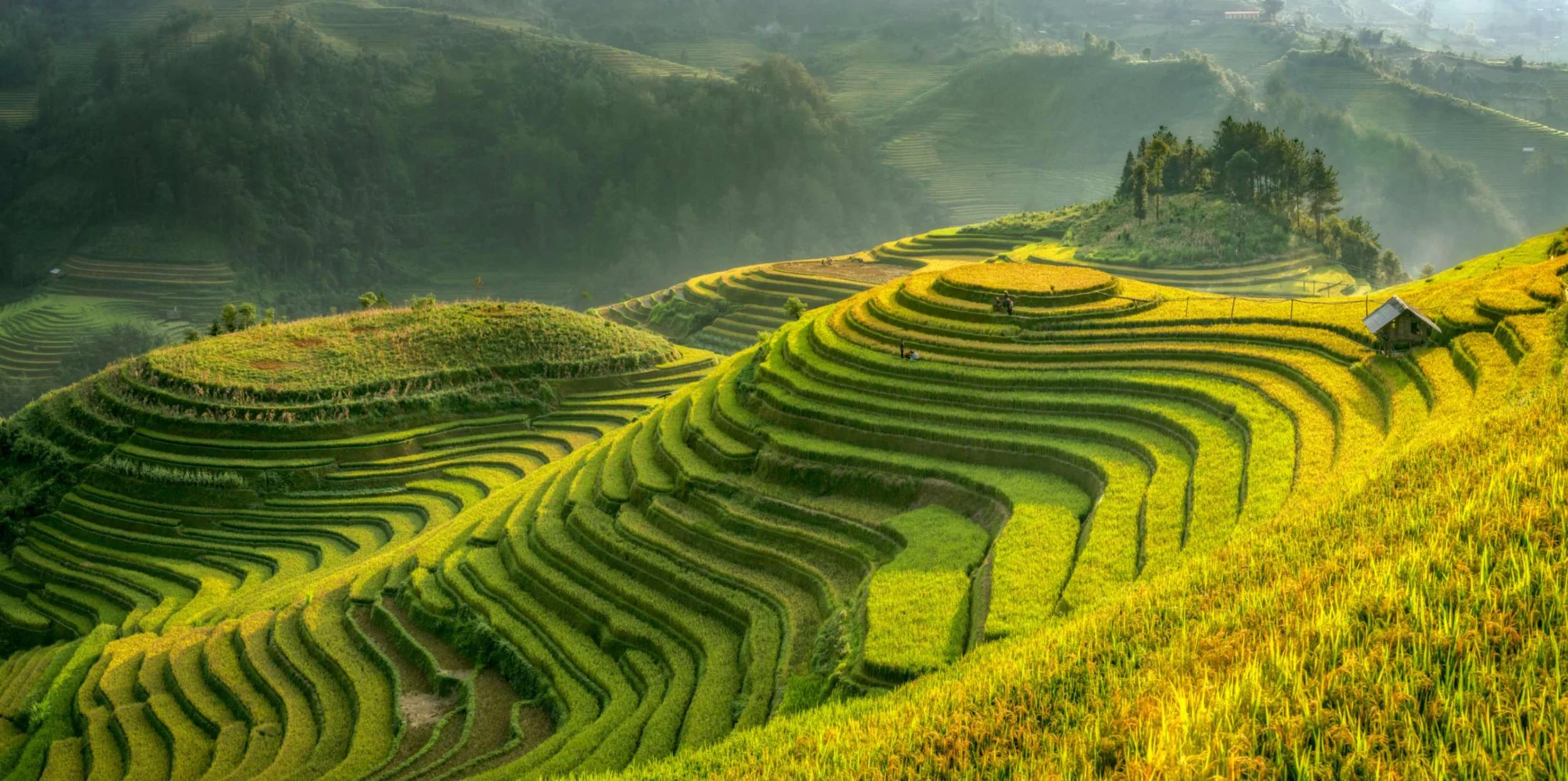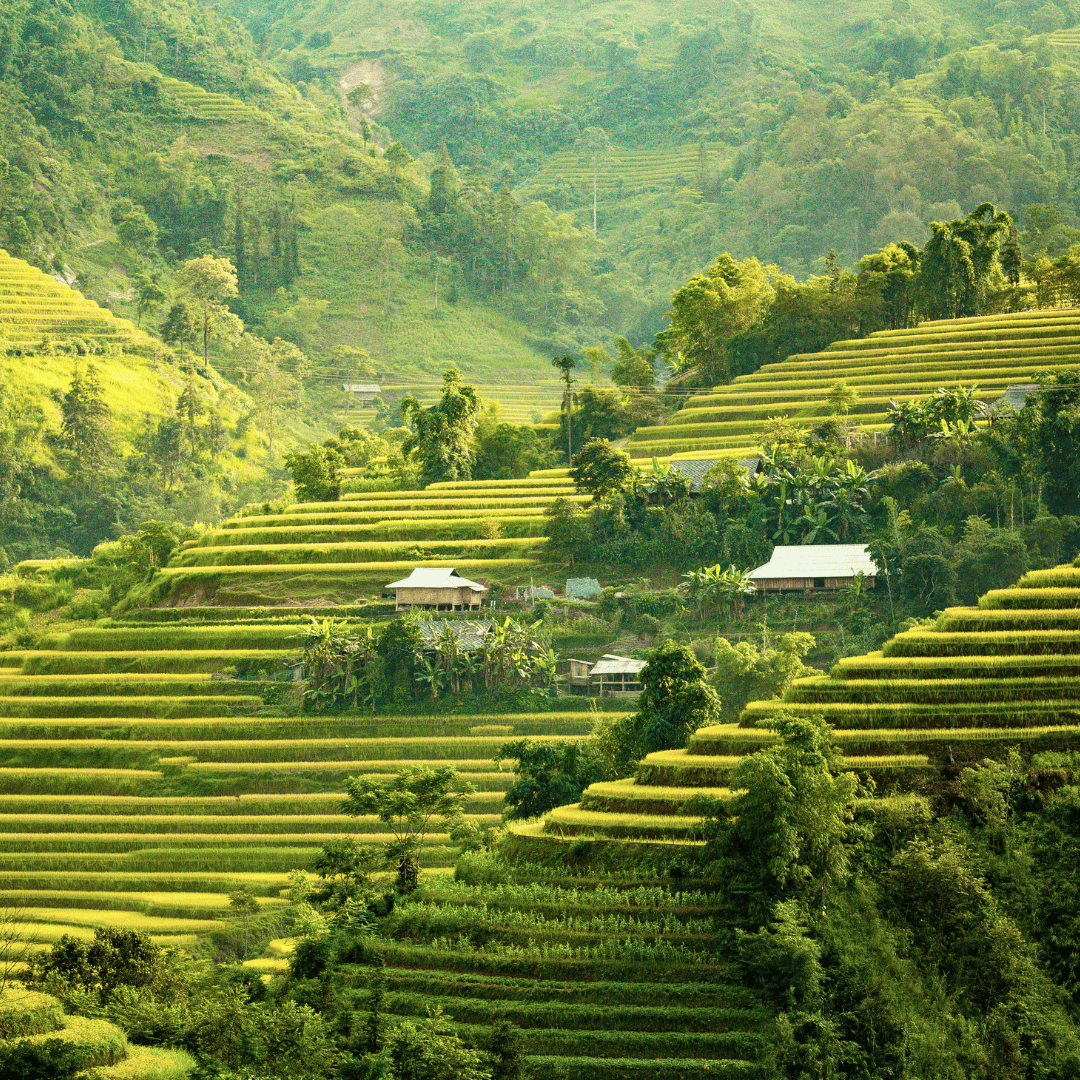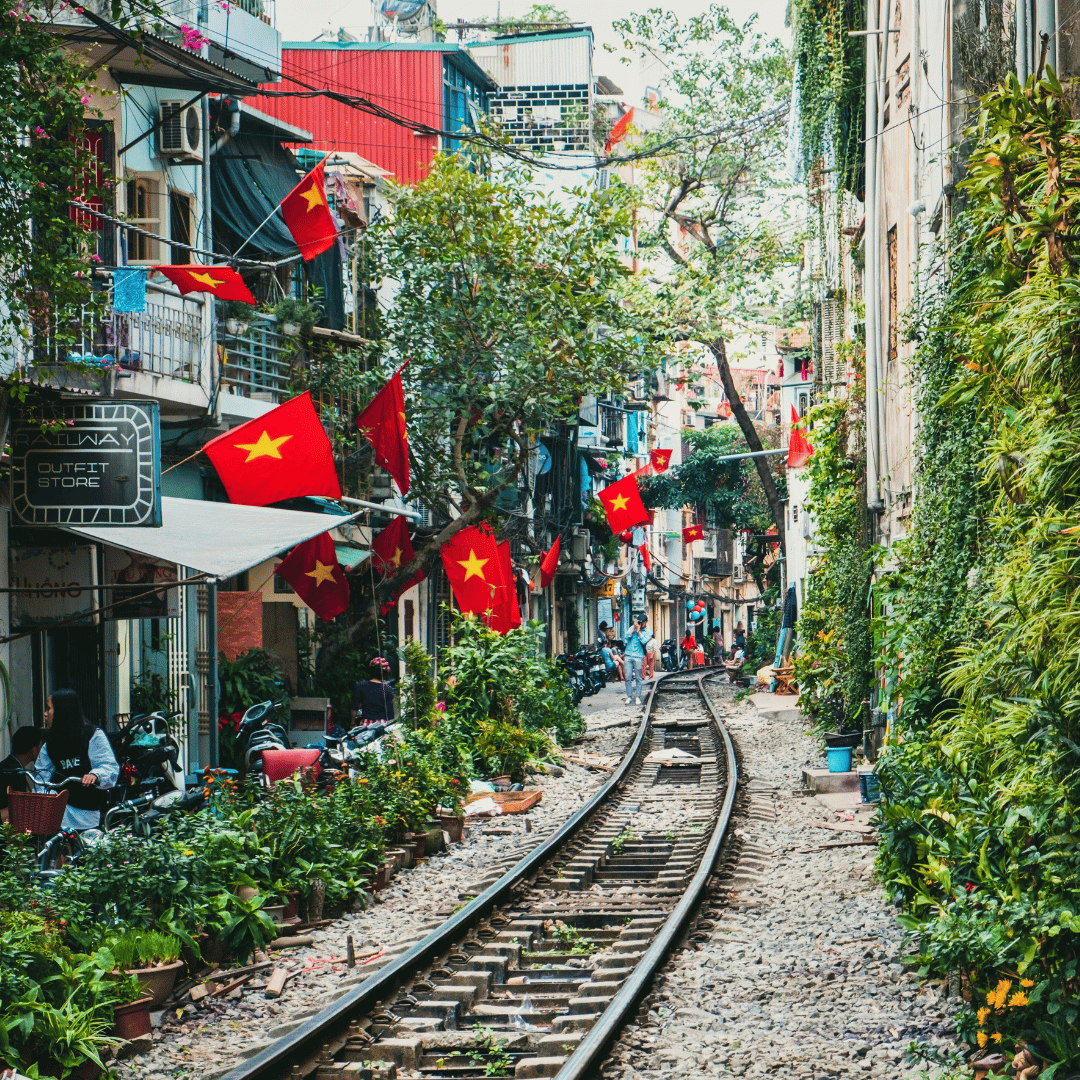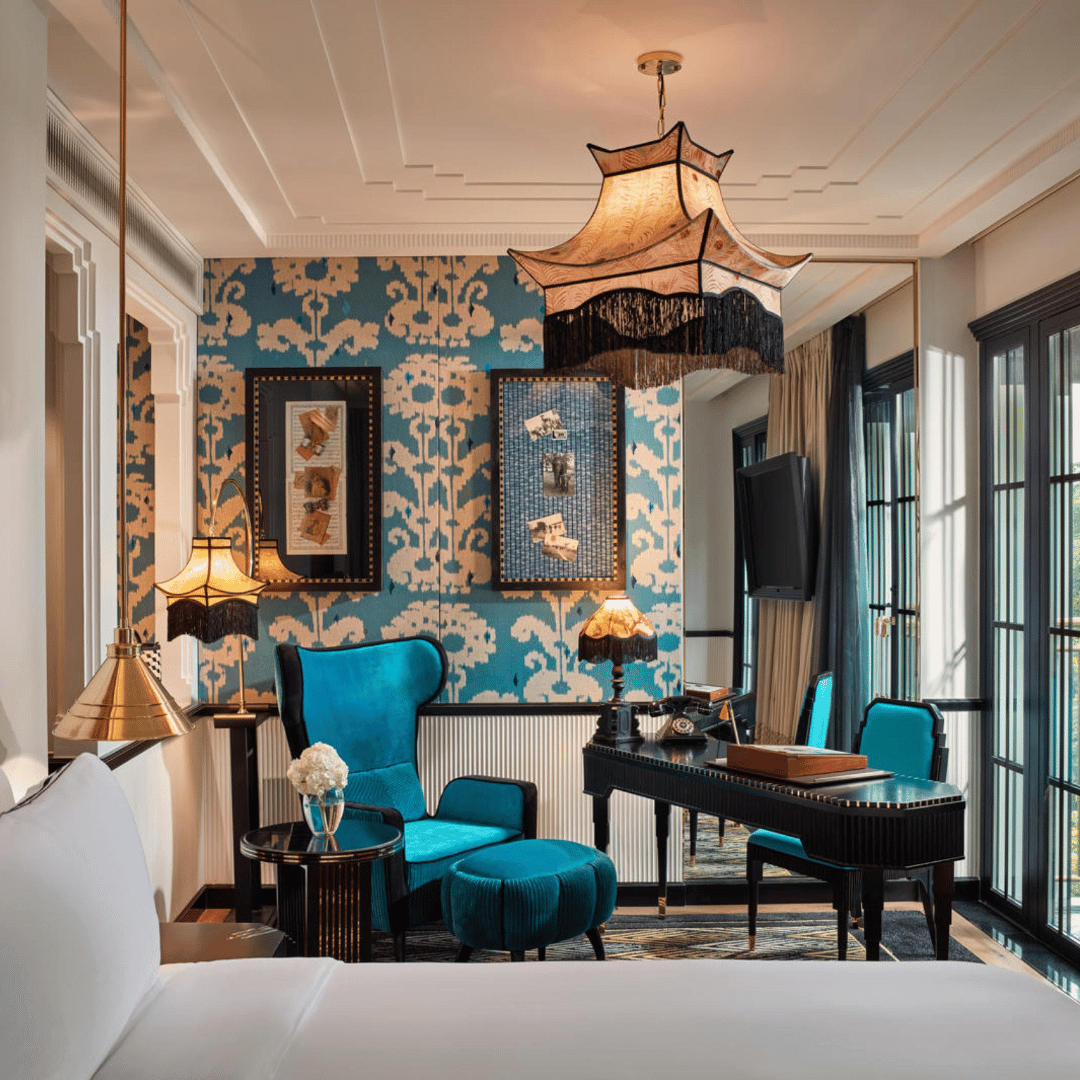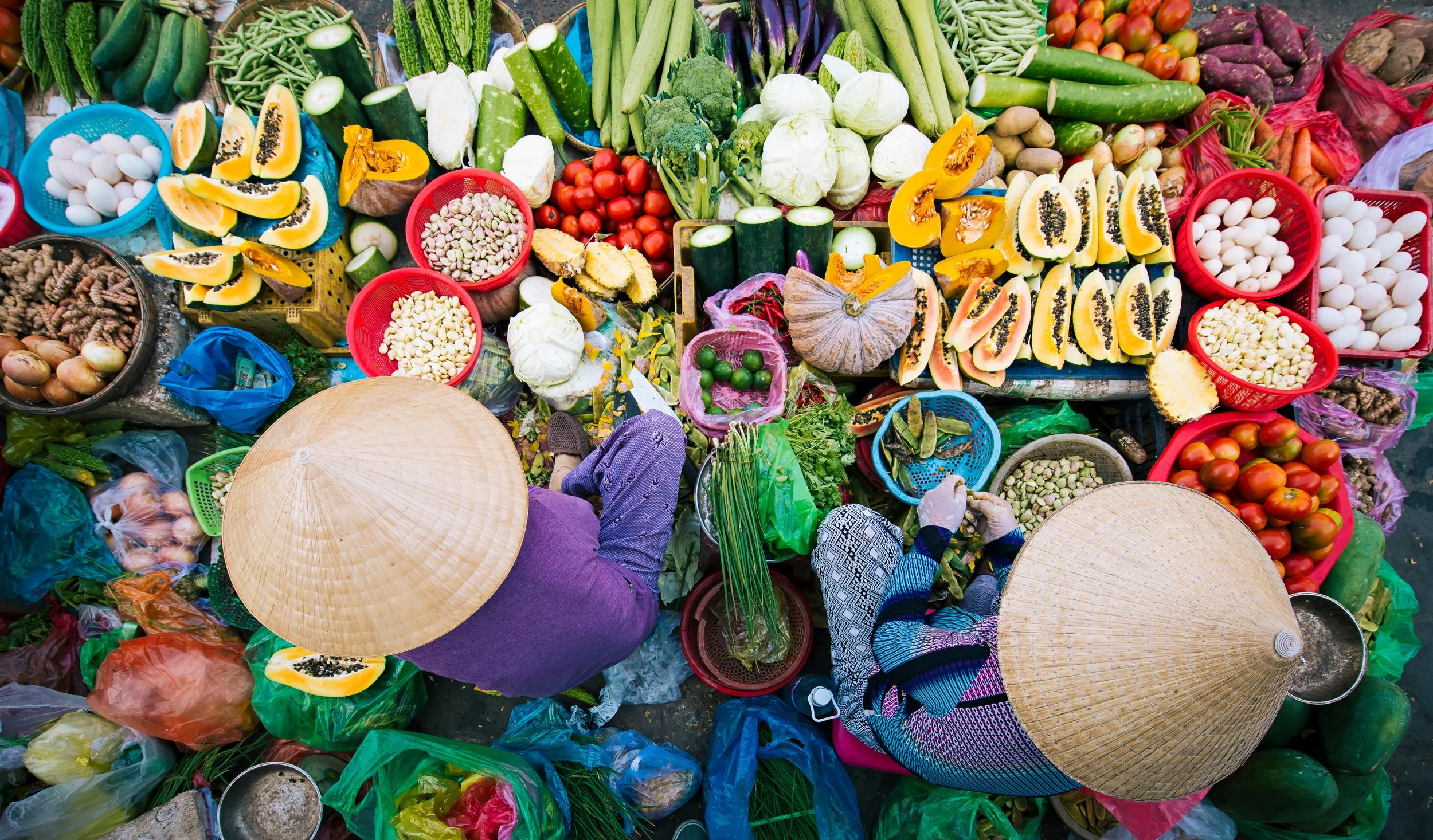
Vietnam Private Tour Packages
Bespoke Itineraries Designed For Australian Travellers
Vietnam is a land of layered history, timeless traditions and striking contrasts, where vibrant cities meet misty mountains and river landscapes. In Hanoi, the Old Quarter’s narrow lanes and tree-lined boulevards reveal a mix of French colonial charm and modern energy, while Hue’s imperial citadel and royal tombs reflect centuries of dynastic rule. Further south, Hoi An captivates with lantern-lit streets, artisan workshops and riverside markets, while the Mekong Delta offers floating villages, fertile fields and journeys by boat through winding waterways. To the north, Ha Long Bay’s limestone cliffs and emerald waters provide one of Asia’s most iconic seascapes, with hidden caves and cruising opportunities.
Private tours of Vietnam can be tailored to your style and interests, combining cultural immersion with time for rest and discovery. This could mean cycling through rice terraces in Sapa, joining a cooking class in Hoi An, exploring Cu Chi’s historic tunnels or relaxing at a luxury retreat on Phu Quoc Island. From lively street life to quiet pagodas and dramatic natural wonders, Vietnam private tour packages offer a rewarding and immersive way to experience this captivating country. At Asia Unbound, we design private journeys across Asia for Australian travellers seeking flexible, well planned experiences and genuine cultural connection.
Our Best Vietnam Tour Itineraries
Vietnam Travel Advice For First Time Visitors
-
When preparing for a trip to Vietnam, there are several important things to know beyond the usual basics. Vietnam is welcoming and easy to travel through, but a little preparation will help you make the most of your journey.
Entry and visas are the first consideration. Many nationalities need a visa to enter Vietnam. The country now offers an efficient e-visa system that can be applied for online in advance, which simplifies the process significantly. Requirements can vary depending on your passport, so it’s always best to check the latest information before travelling. On arrival, make sure you have your visa and passport ready for inspection, and keep a copy of your documents accessible while in the country.
Transport within Vietnam is convenient and varied. Domestic flights link all major cities and allow you to cover long distances quickly, often at very reasonable fares. The train network runs along the coast from Hanoi to Ho Chi Minh City, offering a slower but scenic alternative, with the stretch between Hue and Da Nang especially beautiful. Private cars with drivers are commonly arranged for regional travel, providing both comfort and flexibility. In cities, taxis are widely available, but ride-hailing apps like Grab are often more reliable and easier to use. For short journeys, motorbike taxis are common, though they can feel hectic for first-time visitors.
Money and payments are another important factor. The Vietnamese currency is the dong, and while ATMs are easy to find in cities and towns, cash is still the most widely used form of payment in markets, local eateries and rural areas. Credit cards are accepted at hotels, larger restaurants and shops, but carrying small notes makes day-to-day transactions simpler. It’s also wise to keep an eye on exchange rates and to change money only at official outlets or banks.
Cultural etiquette plays a role in smooth interactions. Respect for elders is central to Vietnamese society, and small gestures such as greeting with both hands when passing or receiving something are appreciated. At pagodas and temples, avoid touching sacred statues or stepping into areas reserved for worship. Smiling and being polite go a long way in daily interactions, and patience is often more effective than pushing for quick results.
Health and safety should be part of your planning too. Vietnam has good hospitals in major cities and reliable pharmacies across the country, but comprehensive travel insurance is essential for peace of mind. Traffic can be overwhelming, particularly in Hanoi and Ho Chi Minh City, where motorbikes dominate the streets. The safest way to cross is to walk slowly and predictably, allowing drivers to adjust around you. Bottled water is readily available and should be used instead of tap water, even for brushing teeth in rural areas.
Connectivity and communication are easy in Vietnam. Wi-Fi is available in most hotels, cafes and airports, and local SIM cards are inexpensive to purchase at airports or convenience stores. Having data makes it easier to use translation apps, navigate city streets, and book taxis or guides on the go.
Timing your visit around public holidays is also useful. Tet, the Vietnamese Lunar New Year, is the country’s most important festival, usually in January or February. It is a vibrant and fascinating time to visit, but many businesses close, and travel services book out early. Other festivals such as Mid-Autumn Festival in September or Hue Festival every two years can add colour and depth to your experience if planned for in advance.
In summary, knowing the basics about visas, transport, money, cultural etiquette, health and connectivity will help you travel with confidence. Vietnam offers a wide variety of experiences, from bustling cities and ancient temples to rural villages and river journeys, and being well prepared ensures you can enjoy it all without unnecessary stress.
-
Vietnam is not divided into states but into 58 provinces (tỉnh) and 5 centrally controlled municipalities (thành phố trực thuộc trung ương). These municipalities function like provinces in their authority but are major cities with special administrative importance. Together they form the backbone of Vietnam’s political, cultural and economic life.
The 5 municipalities are:
Hanoi - the capital in the north, blending historic temples, French colonial buildings and modern development.
Ho Chi Minh City - Vietnam’s largest metropolis, a southern hub of commerce, history and nightlife.
Hai Phong - an important northern port city and gateway to Cat Ba Island and Ha Long Bay.
Da Nang - a fast-growing central coastal city, known for its beaches, Marble Mountains and proximity to Hoi An and Hue.
Can Tho - the cultural and economic centre of the Mekong Delta, famous for its floating markets and riverside life.
Beyond these, the 58 provinces are typically grouped into three broad regions:
Northern Vietnam
This region is mountainous and culturally diverse, home to many ethnic minority groups. Provinces include Lao Cai (gateway to Sapa’s terraced rice fields), Ha Giang (spectacular mountain passes), Cao Bang (Ban Gioc Waterfall), Ninh Binh (limestone karsts and waterways) and Quang Ninh (Ha Long Bay). Hanoi, the capital, is also in the north.Central Vietnam
Stretching along the coast and central highlands, this region includes Thua Thien-Hue (the imperial capital of Hue), Quang Nam (Hoi An and My Son ruins), Quang Binh (Phong Nha caves), Da Nang (a key municipality), and Khanh Hoa (home to Nha Trang’s beaches). The central highlands cover provinces like Dak Lak and Lam Dong, known for coffee, waterfalls and pine forests.Southern Vietnam
Centred on Ho Chi Minh City, the south includes provinces such as Ba Ria-Vung Tau (coastal resorts), Dong Nai (industrial and natural parks), and Kien Giang (home to Phu Quoc Island). Can Tho anchors the Mekong Delta, alongside provinces like Ben Tre, Vinh Long and An Giang, where travellers encounter floating markets, riverside villages and fertile farmland.For travellers, the provinces and municipalities are less about political boundaries and more about experiences. Some places are famous for natural beauty, others for cultural heritage, and many for their mix of both. The diversity means itineraries often cross regions - from Hanoi and northern mountains, down through Hue and Hoi An in central Vietnam, to Ho Chi Minh City and the Mekong Delta in the south.
-
The official language of Vietnam is Vietnamese (tiếng Việt), which is spoken throughout the country by the majority of the population. It uses the Latin alphabet with additional diacritics to indicate tones and pronunciation. As a tonal language, the meaning of a word changes depending on the pitch or tone, which makes it quite different from English.
There are also many regional accents and dialects. Northern, central and southern Vietnamese can sound quite different from each other, though they remain mutually intelligible. Hanoi is considered the standard for official use, while Ho Chi Minh City has its own widely spoken southern style.
Vietnam is also home to more than 50 ethnic minority groups, many of whom speak their own languages. In the northern highlands, you’ll hear Hmong, Dao, Tay and Thai languages, while in the central highlands there are languages like Ede, Jarai and Bahnar. Khmer is spoken in some southern provinces near Cambodia, and Chinese dialects can be heard in certain communities.
For travellers, English is increasingly common, especially in major cities, tourist centres, hotels and among younger generations. French still lingers in some cultural and educational contexts, a legacy of colonial history. Learning a few simple Vietnamese phrases such as xin chào (hello) or cảm ơn (thank you) is always appreciated and makes interactions warmer.
-
The best time to visit Vietnam depends on where you are travelling, as the country stretches over 1,600 kilometres from north to south and has three distinct climate zones. There is no single perfect season that covers every destination, but with good planning you can enjoy comfortable weather almost year-round.
In North Vietnam (Hanoi, Ha Long Bay, Ninh Binh, Sapa, Ha Giang), the best conditions are usually from October to April. During these months the air is cooler and drier, making it ideal for walking tours in Hanoi’s Old Quarter, cruising Ha Long Bay under clear skies or trekking in the northern mountains. December and January can be surprisingly cold in Sapa and Ha Giang, sometimes dropping close to freezing, so warm clothing is essential for overnight stays. From May to September, the north experiences heat and humidity with heavier rains, though the rice terraces around Sapa and Mu Cang Chai are at their most spectacularly green during this time.
In Central Vietnam (Hue, Da Nang, Hoi An, Phong Nha, Nha Trang), the most reliable weather falls between February and August. This is the dry season, bringing sunny skies and warm temperatures that are perfect for exploring Hue’s citadel, cycling around Hoi An’s countryside or relaxing on the beaches around Da Nang and Nha Trang. Between September and January, the region often experiences rain and occasional typhoons, particularly around Hue and Hoi An, so itineraries at this time require more flexibility. However, the cultural sites remain open and the rains can bring a quieter, more atmospheric experience.
In South Vietnam (Ho Chi Minh City, Mekong Delta, Phu Quoc, Con Dao), the climate is more consistent. The dry season runs from November to April, offering warm sunny days well-suited for river cruises in the Mekong or beach stays on Phu Quoc. The wet season, from May to October, brings short afternoon downpours but rarely disrupts travel completely. In fact, many travellers find the countryside at its most beautiful during these months, with green rice fields and abundant fruit harvests in the Mekong Delta.
For those planning a journey across multiple regions, the most balanced periods are spring (March-April) and autumn (October-November). These months generally offer favourable weather across most of the country, allowing you to combine the north, centre and south without encountering extremes of heat or rain.
Festivals and cultural events can also influence timing. Tet, the Vietnamese Lunar New Year, usually in January or February, is the country’s biggest holiday. Streets fill with celebrations and temples are lively, but many businesses close and transport can book out weeks in advance. Other highlights include the Mid-Autumn Festival in September, Hue Festival every two years in Central Vietnam, and local harvest festivals in the northern mountains. Planning your trip around these dates can add a special dimension to your journey.
-
When packing for Vietnam, it helps to think about comfort, climate and cultural respect. The country stretches from cool northern mountains to tropical southern islands, so the type of clothing you bring will depend on your route and the season.
For everyday sightseeing in cities like Hanoi, Hue or Ho Chi Minh City, lightweight, breathable fabrics such as cotton and linen are best. Days can be long with lots of walking, so comfortable shoes or sandals are essential. A hat and sunglasses are useful for sun protection, and a light rain jacket or umbrella comes in handy during the wet season.
When visiting temples, pagodas and sacred sites, modest dress is expected. It is respectful to cover shoulders and knees, so carrying a scarf or light shawl is useful if you’re wearing short sleeves. Shoes must always be removed before entering temples, so slip-on footwear makes things easier.
If you are heading to the northern mountains around Sapa or Ha Giang, temperatures can drop sharply from November to February, especially at night. A warm jumper or jacket is recommended, along with sturdy walking shoes for trekking through terraced rice fields.
For the south and coastal areas, such as the Mekong Delta, Phu Quoc or Nha Trang, lighter clothing is fine. Swimsuits are acceptable on beaches and at resorts, but it is good etiquette to cover up when leaving the water and moving through towns or villages.
Overall, dress in Vietnam is practical and relaxed, with an emphasis on being prepared for changing conditions. Travellers who balance comfort with cultural sensitivity will find they fit in well and enjoy smooth interactions throughout their journey.
-
Eating in Vietnam is one of the country’s greatest pleasures and a big part of daily life. Vietnamese cuisine is famous for balancing four key flavours - sweet, sour, salty and spicy - often in a single dish. Meals are built around fresh herbs, rice noodles, vegetables and locally sourced ingredients, creating food that feels both light and full of flavour. What makes eating here so special is not just the taste, but also how dishes vary between regions, shaped by climate, history and culture.
In the north, the food is more subtle, with less spice and a focus on clarity of flavour. Hanoi is considered the birthplace of pho, the iconic noodle soup usually served with beef or chicken, topped with lime, fresh herbs and chilli to taste. Another local classic is bun cha, grilled pork patties and slices of pork belly served with rice noodles, fresh herbs and dipping sauce. The cooler climate means dishes are often heartier, with freshwater fish, crab and seasonal greens from the Red River Delta playing a big role.
Moving to central Vietnam, flavours become bolder, spicier and more complex. Hue, once the imperial capital, is known for its refined royal cuisine and dishes like bun bo Hue, a rich beef noodle soup with lemongrass and chilli. Small savoury bites, such as steamed rice cakes topped with shrimp or pork, are also popular. In Hoi An, dishes reflect the town’s trading history. Cao lau, noodles served with pork, greens and crispy croutons, is a signature, while white rose dumplings are another unique specialty. Central food is known for its balance of heat, sourness and aromatic herbs.
In the south, the food is sweeter and more tropical, thanks to fertile farmland and the Mekong Delta. Banh mi, a crusty French-style baguette filled with pork, pate, pickles and herbs, is a street food staple. Com tam, or broken rice, served with grilled meat, egg and vegetables, is another favourite. The south also produces an incredible variety of fruits - mango, rambutan, dragon fruit and longan - often eaten fresh or as part of desserts. Coconut milk features heavily in cooking, from savoury stews to sweets.
Street food is also central to Vietnamese life. Every town has its own specialties, often served from small stalls or mobile carts. Sitting on low plastic stools at a roadside table with locals, tucking into bowls of noodles or freshly rolled spring rolls, is one of the most authentic experiences you can have. Dishes like banh xeo (crispy rice pancakes), goi cuon (fresh spring rolls with prawns and herbs) and che (a sweet dessert soup with beans, fruit and coconut) showcase the variety and creativity of everyday Vietnamese cooking.
Beyond the food itself, eating in Vietnam is also about connection and culture. Meals are often shared, with dishes placed in the middle of the table so everyone can taste a little of everything. Local markets are vibrant places to explore, full of fresh produce, spices and snacks, while cooking classes with Vietnamese chefs are an excellent way to learn the stories behind the dishes.
-
The number of days you should spend in Vietnam really depends on how deep you want to explore the country and how fast you like to travel. Vietnam is long and narrow, stretching more than 1,600 kilometres from the mountains of the north to the tropical islands of the south. Each region offers very different experiences, so the amount of time you have will shape the style of journey you can take.
If you have 5 to 7 days, the most rewarding approach is to focus on a single region rather than trying to see the entire country. In the north, a week could be spent discovering Hanoi’s Old Quarter, taking a day trip to Ninh Binh, and enjoying an overnight cruise on Ha Long Bay. In the south, you might split your time between Ho Chi Minh City and the Mekong Delta, adding a couple of nights on Phu Quoc Island for relaxation. This short timeframe works well if Vietnam is only one part of a larger South East Asia journey, perhaps combined with Cambodia, Laos or Thailand.
With 10 to 14 days, you can follow a classic north-to-south route that includes Vietnam’s highlights. Many travellers start in Hanoi with a city tour and then cruise Ha Long Bay. From there, a flight takes you to Hue to explore the imperial citadel, before continuing over the scenic Hai Van Pass to Hoi An for lantern-lit streets, local markets and countryside cycling. The trip usually ends in Ho Chi Minh City, with time for colonial landmarks, bustling street food tours, and a day in the Mekong Delta. This amount of time also allows for some variation, such as adding Sapa for trekking in the northern highlands or extra beach days on the central coast in Da Nang or Nha Trang.
If you have three weeks or more, you can experience Vietnam in depth and at a slower, more relaxed pace. This might include all of the highlights plus off-the-beaten-path regions like Ha Giang, where dramatic mountain scenery and ethnic minority villages offer a very different perspective. You could also spend time in the central highlands around Dalat or Buon Ma Thuot, visit national parks such as Cuc Phuong or Cat Tien, or explore quieter Mekong provinces such as Ben Tre or An Giang. Longer trips allow you to travel overland by train, boat and car instead of relying solely on flights, giving you more connection with the landscapes and people.
Festivals and seasonal events may also influence how much time you want to spend. For example, visiting during Tet, the Lunar New Year, is fascinating but requires more days to adjust for closures and busy transport. Spending longer in the north during harvest season allows time to explore terraced rice fields in full colour, while the south rewards extra days during fruit harvest season with festivals and local feasts.
In summary, a week is ideal for an introduction, two weeks gives a rounded and balanced holiday, and three weeks or more allows for deeper, more authentic experiences across the country. Because Vietnam’s appeal lies in its contrasts - lively cities, quiet villages, dramatic coastlines and mountain scenery - the longer you can spend, the richer and more diverse your trip will feel.
-
Yes, combining a private tour of Vietnam with another country is one of the most rewarding ways to experience South East Asia. Thanks to Vietnam’s central location and excellent transport links, it is easy to pair it with Cambodia or Laos in one seamless journey. Many travellers find that exploring two neighbouring countries together gives a deeper sense of history, culture and landscape, without adding too much travel time.
A natural combination is Vietnam and Cambodia. From Ho Chi Minh City, you can travel by boat along the Mekong River to Phnom Penh, which makes for a memorable cross-border experience, or you can fly directly in less than two hours. Phnom Penh’s Royal Palace, riverside markets and Khmer Rouge history provide a striking contrast to Vietnam’s southern bustle. Many itineraries then continue to Siem Reap to explore the temples of Angkor, one of the world’s most extraordinary archaeological sites. Ending a Vietnam journey with Angkor at sunrise or sunset is a powerful way to tie together themes of heritage and cultural continuity.
Vietnam also pairs beautifully with Laos, especially from the north. Travellers can cross by land or river from Dien Bien Phu or cross near Sapa and continue into Luang Prabang. Alternatively, there are short flights linking Hanoi with Luang Prabang and Vientiane. Laos offers a slower, more contemplative experience compared to Vietnam’s busy cities. Monks collecting alms at dawn in Luang Prabang, the French colonial architecture, riverside cafes and nearby waterfalls give travellers a sense of timeless calm. Combining Hanoi’s energy and Ha Long Bay’s landscapes with Luang Prabang’s meditative atmosphere is a balance many visitors treasure.
For those who want every detail carefully handled, Asia Unbound specialises in creating private tours that link Vietnam with Cambodia and Laos. With teams on the ground in each country, the focus is on designing itineraries that move smoothly across borders, whether by road, river or air. Journeys can be tailored to blend cultural highlights, such as Hue’s imperial citadel or Angkor Wat, with authentic local encounters like cooking classes, village walks and market visits. Travellers benefit from the same standard of comfort, curated accommodation and 24/7 support across all destinations, ensuring a consistent and personalised experience.
Popular Places To Visit In Vietnam
Plan Your Vietnam Itinerary With Asia Unbound
Established in 2007, Unbound Travel Group is a collection of tourism brands specialising in highly curated private touring and small group journeys throughout Asia. With more than two decades of experience, we create bespoke itineraries for discerning travellers looking for a real adventure. Based in Australia, our team uses our on-the-ground experience and first-hand knowledge to carefully curate experiences that are innovative and authentic.
When you start to research a trip to Asia, it’s easy to feel overwhelmed by the seemingly endless possibilities, especially if you don’t want to join a group tour. At Asia Unbound, we’ve made this process easy. We simply need you to tell us relevant information about yourself and the type of travel experience you are looking for - whether it’s a wish list of places you want to visit, a style of travel, a particular interest or theme that you want to explore, or all of these factors. Using this information, we curate a custom-made Asia private tour just for you. It’s that simple.
Vietnam Hotel Recommendations
